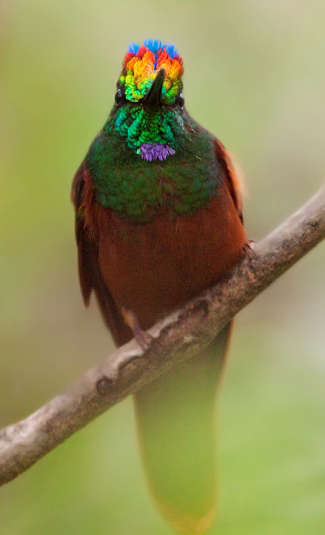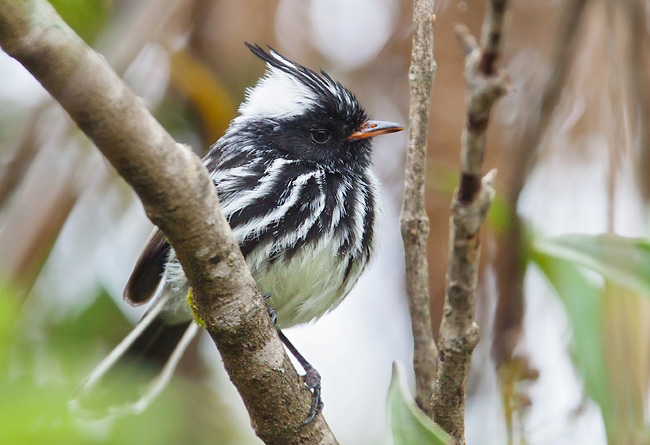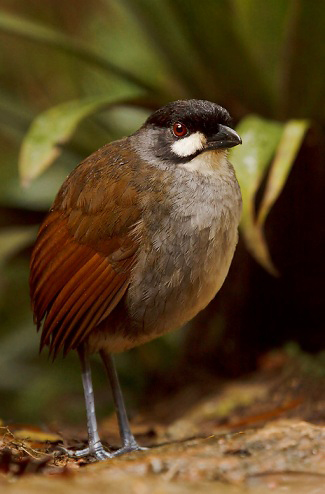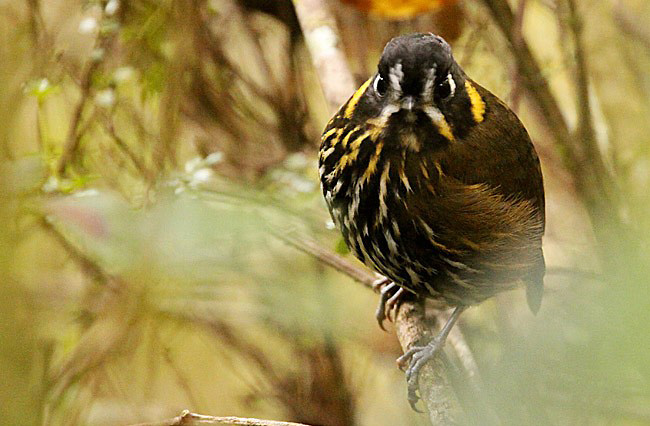

The amazing Rainbow Starfrontlet at the Utuana Reserve in Southern Ecuador by Dubi Shapiro.
- There are over 1600 bird species in mainland Ecuador, a country less than a quarter the size of Colombia (over 1950 species) and no bigger than Colorado; more birds per square mile than any other country in the world
- Thanks mainly to the close proximity of Andean highland temperate forests and Amazonian lowland tropical forests but also a wide range of other habitats, especially in Southern Ecuador where the coastal wetlands, arid Tumbesian scrub-forest, Amazonian forest, east and west Andean foothill forest, and High Andes combine to support a terrific range of birds
- Including Ecuadorian endemics such as El Oro Parakeet and Esmeraldas Woodstar
- Over 40 Tumbesian endemics shared with northwest Peru including Henna-hooded Foliage-gleaner, Chapman’s and Collared Antshrikes, Watkins's Antpitta, Elegant Crescentchest, Pacific Royal Flycatcher, Ecuadorian and Plumbeous-backed Thrushes, and White-tailed Jay
- Other specialities such as Velvet-purple Coronet, Ecuadorian Hillstar, Crescent-faced and Jocotoco Antpittas, Black-crested Tit-tyrant, Fiery-throated and Scaled Fruiteaters, Grey-tailed Piha, Amazonian and Long-wattled Umbrellabirds, Blue-rumped and Club-winged Manakins, Orange-throated and White-capped Tanagers, Tit-like Dacnis and Giant Conebill
- And more widespread spectacular birds including Horned Screamer, Torrent Duck, Rufous-necked Wood-rail, Black-eared and Purple-crowned Fairies, Grey-breasted Mountain-toucan, Wing-barred Piprites, Andean Cock-of-the-rock, Golden-winged Manakin, Musician Wren and numerous tanagers
- Hence it is possible to see 500-600 or even more bird species in two to three weeks in Southern Ecuador
- And even a few mammals, including Mantled Howler Monkey
- The world record for the number of birds recorded in 24 hours was set in Ecuador on the 8th of October 2015 by Dusan Brinkhuizen, Rudy Gelis, Mitch Lysinger and Tuomas Seimola. The old record of 354 (see below) was broken between the lowland Amazon rain forest near Tena in the east and the Papallacta area in the Andes and yet more birds were recorded near Quito, bringing the total to 385 by dusk. The team then took a commercial flight to the Santa Elena peninsula on the Pacific coast in southern Ecuador and added many more species at roost and in their ringing nets to reach an incredible total of 425! The previous record was set in Northern Peru in October 2014 when a total of 354 species (of which just 232 were actually seen) was recorded by a team from Louisiana State University Museum of Natural Science. This total was recorded along a transect from montane forest in the Abra Patricia area down to Amazonian lowland forest near Moyobamba. The record before that, which stood for nearly 30 years, was set in Kenya in 1986 when, with the aid of a light aircraft, a total of 342 species was reached (of which an incredible 333 were seen). The best total before 1986 was set in Peru, at Cocha Cashu Biological Station in Manu National Park, Southern Peru, in 1982, and this is still arguably the most impressive, because Ted Parker and Scott Robinson recorded an incredible 331 species in a square mile!
- On a trip to Northern Ecuador which includes the Andes and Amazonia lasting three to four weeks it is possible to record over 850 species and on the Birdquest Ultimate Ecuador tour in October 2016 an astonishing 891 species were recorded (825 of which were seen) in 25 days including 720 during the first 16 days before the Amazonia section, a list which included 77 hummingbirds, 21 nightbirds, 22 woodpeckers, 14 toucans, 18 cotingas and 107 tanagers and allies, with individual species such as Agami and Zigzag Herons, Rufous-bellied Seedsnipe, Oilbird, Black-billed and Plate-billed Mountain-toucans, Sapayoa, Rufous-crowned Pittasoma, Black-necked Red-cotinga and Scarlet-and-white Tanager! However, in neighbouring Colombia over 1000 species are possible in a month and Rockjumper have managed this on three occasions, including 2014 when they recorded an incredible 1044 species in 29 days in January-February! A list which included 63 endemics, 36 parrots, 9 owls, 11 nightjars, 86 hummingbirds, 10 trogons, 15 puffbirds, 16 toucans, 27 woodpeckers, 60 antbirds, 14 antpittas, 14 cotingas, 12 manakins and 113 tanagers and allies.
- The rare endemic Esmeraldas Woodstar occurs (mainly Jan–Apr) in Jocotoco's Rio Ayampe Reserve near the west coast of Ecuador, along with Ochre-bellied Dove, Ecuadorian Trogon, Little and Short-tailed Woodstars, Henna-hooded Foliage-gleaner and Superciliated Wren. Since 2017, Fundacion Jocotoco has released a total of 14 Great Green Macaws here, the macaws having disappeared from the region some 50 years ago as a result of loss of habitat to agriculture, ranching and illegal collection for the pet trade.
- On and around Isla de la Plata, sometimes called 'The Poor Man's Galapagos', in Machalilla National Park but 30 km/1.5 to 2 hours by boat out of Puerto Lopez off the west coast of Ecuador, it is possible to see nesting Waved Albatrosses (adults usually have small chicks by the second half of July although sometimes the nests are declared 'off-limits' to the visiting public), as well as Red-billed Tropicbirds, Magnificent Frigatebirds, and Blue-footed (displaying their feet during the second half of July) and Nazca Boobies, while landbirds include Short-tailed Woodstar, Long-tailed Mockingbird, Grey-and-white Tyrannulet, Vermilion Flycatcher and Collared Warbling-finch. Snorkelling is excellent and during the boat trips to and from the island it is possible to see Green Turtles and Humpback Whales (mostly May-Sep). In the national park on the mainland there is a chance of Southern Tamandua with Chilean Flamingos nearby.
- The only other place in the world where Waved Albatrosses nest is the Galapagos. Many tour companies include these islands in their itineraries to Northern Ecuador or offer a trip there as an extension and as well as the albatrosses and other seabirds mentioned under Machalilla there are Red-footed Boobies, Great Frigatebirds, Swallow-tailed Gulls, and over 20 endemic bird species including Galapagos Penguin, Flightless Cormorant, and several mockingbirds and finches, as well as Giant Tortoises and Marine Iguanas.

The very handsome Black-crested Tit-tyrant in the Utuana Reserve, Southern Ecuador by Dubi Shapiro.
Best Birds and other wildlife in Southern Ecuador
Birds
Endemics (whole of Ecuador) 8 Northwest 1 Black-breasted Puffleg.
(Turquoise-throated Puffleg is known only from a few specimens taken in the nineteenth century)
West 2 Esmeraldas Woodstar and Lilacine (Red-lored) Amazon.
South/Southwest 5 Blue-throated Hillstar, Violet-throated Metaltail, El Oro Parakeet, Ecuadorian Tapaculo and Pale-headed Brush-finch.
Near-endemics (whole of Ecuador)
Ecuador and Colombia 100 (20 hummingbirds, five antpittas, an umbrellabird and 13 tanagers) Berlepsch’s Tinamou, Baudo Guan, Rufous-fronted Wood-quail, Dark-backed Wood-quail, Dusky Pigeon, Purple Quail-dove, Choco Poorwill, White-whiskered Hermit, Western Wedge-billed Hummingbird, Gorgeted Sunangel, Tourmaline Sunangel, Violet-tailed Sylph, Ecuadorian Hillstar, Viridian Metaltail, Hoary Puffleg, Black-thighed Puffleg, Sapphire-vented Puffleg, Golden-breasted Puffleg, Brown Inca, Velvet-purple Coronet, Rufous-gaped Hillstar, Purple-bibbed Whitetip, Pink-throated Brilliant, Empress Brilliant, Western Emerald, Purple-chested Hummingbird, Gray’s Hummingbird (Blue-headed Sapphire), Banded Ground-cuckoo, Brown Wood-rail, Cloudforest Pygmy-owl, Colombian (Rufescent) Screech-owl, Choco Trogon, Choco Toucan, Plate-billed Mountain-toucan, Orange-fronted Barbet, Five-coloured Barbet, Toucan Barbet, Lita Woodpecker, Choco Woodpecker, Plumbeous Forest-falcon, Carunculated Caracara, Rose-faced Parrot, Choco (Maroon-tailed) Parakeet, Cocha Antshrike, Stub-tailed Antbird, Esmeraldas Antbird, Rufous-crowned Pittasoma, Giant Antpitta, Moustached Antpitta, Bicoloured Antpitta, Yellow-breasted Antpitta, Crescent-faced Antpitta, Narino Tapaculo, Spillmann’s Tapaculo, Pacific Tuftedcheek, Stout-billed Cinclodes, Uniform Treehunter, Fulvous-dotted Treerunner, Club-winged Manakin, Yellow-headed Manakin, Orange-breasted Fruiteater, Chestnut-bellied Cotinga (likely to occur in north Peru), Long-wattled Umbrellabird, Pacific Flatbill, Northern Ornate Flycatcher, Choco Tyrannulet, Coopmans’s Elaenia, Plain-capped Ground-tyrant, Black-billed Peppershrike, Pale-legged (Slaty-capped) Shrike-vireo, Choco Vireo, Beautiful Jay, Quindio (Black-collared) Jay, Black Solitaire, Chestnut-throated (Rufous-brown) Solitaire, Tanager Finch, Dusky Bush-tanager, Choco (Tricoloured) Brush-finch, White-rimmed Brush-finch, Olive-crowned Yellowthroat, Choco (Golden-bellied) Warbler, Ochre-breasted Tanager, Scarlet-and-white Tanager, Scarlet-breasted Dacnis, Yellow-tufted (Black-faced) Dacnis, Black-winged Saltator, Western Black-eared Hemispingus, Stolzmann’s Tanager (Black-backed Bush Tanager), Ochraceous (Cinereous) Conebill, Indigo Flowerpiercer, Purplish-mantled Tanager, Black-chinned Mountain-tanager, Glistening-green Tanager, Yellow-green Tanager (Chlorospingus), Moss-backed Tanager, Golden-chested Tanager, Rufous-throated Tanager, Scrub Tanager, Yellow-faced (Flame-faced) Tanager and Blue-whiskered Tanager.
Ecuador, Colombia and Peru 38 Pallid Dove, Ecuadorian Piedtail, Rainbow-bearded Thornbill, Buff-winged Starfrontlet, Chestnut-breasted Coronet, Green-backed (White-tailed) Hillstar, Rufous-vented Whitetip, Cinnamon Screech-owl, Coppery-chested Jacamar, Brown Nunlet, Guayaquil Woodpecker, Scarlet-backed Woodpecker, Pacific Parrotlet, Yasuni Stipplethroat (Antwren), Chestnut-naped Antpitta, White-bellied Antpitta, Western Tawny Antpitta, Long-tailed Tapaculo, Paramo Tapaculo, Pacific Hornero, Spectacled Prickletail, Grey-tailed Piha, Dusky Piha, Foothill Schiffornis, Ecuadorian Tyrannulet, Orange-eyed Flatbill (Flycatcher), Ochraceous Attila, Snowy-throated Kingbird, Mouse-grey (Bran-coloured) Flycatcher, Turquoise Jay, Plain-tailed Wren, Orange-crowned Euphonia, Ecuadorian Cacique, Scrub Blackbird, Ecuadorian (Blue) Seedeater, Masked Saltator, Masked Mountain-tanager and Golden-naped Tanager.
Ecuador and Peru 108 (13 hummingbirds, three antpittas and 17 tyrant flycatchers) Pale-browed Tinamou, Peruvian Pigeon, Ochre-bellied Dove, Ecuadorian Ground-dove, Scrub Nightjar, Porculla (Grey-chinned) Hermit, Ecuadorian (Long-billed) Hermit, Little Sunangel, Purple-throated Sunangel, Royal Sunangel, Green-headed Hillstar, Neblina Metaltail, Rainbow Starfrontlet, Peruvian (Booted) Racket-tail, Tumbes Hummingbird, Amazilia Hummingbird, Short-tailed Woodstar, Purple-collared Woodstar, Imperial Snipe, Peruvian Screech-owl, Grey-backed Hawk, Ecuadorian Trogon, Black-billed (Emerald) Toucanet, Pale-billed (Collared) Aracari, Ecuadorian Piculet, Northern Andean Flicker, Dusky-winged (Lineated) Woodpecker, Grey-cheeked Parakeet, Red-faced Parrot, Wavy-breasted (Rose-fronted) Parakeet, White-necked Parakeet, Cordilleran (Scarlet-fronted) Parakeet, Red-masked Parakeet, Ancient Antwren, Chapman’s Antshrike, Collared Antshrike, Lunulated Antbird, Grey-headed Antbird, Maranon Crescentchest, Elegant Crescentchest, Watkins’s Antpitta, Jocotoco Antpitta, Peruvian Antpitta, Chusquea Tapaculo, Rufous-necked Foliage-gleaner, Henna-hooded Foliage-gleaner, Mouse-coloured Thistletail, Equatorial Greytail, Line-cheeked Spinetail, Maranon Spinetail, Blackish-headed Spinetail, Necklaced Spinetail, Jet Manakin, Scaly-breasted (Scarlet-breasted) Fruiteater, Pacific Royal Flycatcher, Slaty Becard, Cinnamon-breasted Tody-tyrant, Orange-banded Flycatcher, Loja Tyrannulet, Tawny-fronted (Tawny-crowned) Pygmy-tyrant, Pacific Elaenia, Tumbes (Mouse-coloured) Tyrannulet, Grey-and-white Tyrannulet, Rufous-winged Tyrannulet, Black-crested Tit-tyrant, Baird’s Flycatcher, Sooty-crowned Flycatcher, Olive-chested Flycatcher, Jelski’s Chat-tyrant, Tumbes Tyrant, Andean (Jelski’s) Black-tyrant, Grey-breasted Flycatcher, Western Tropical Pewee, Olivaceous Greenlet, White-tailed Jay, Chestnut-collared Swallow, Tumbes Swallow, Fasciated Wren, Speckle-breasted Wren, Maranon Wren, Bar-winged Wood-wren, Long-tailed Mockingbird, Ecuadorian Thrush, Plumbeous-backed Thrush, Maranon Thrush, Saffron Siskin, Tumbes Sparrow, Black-capped Sparrow, Maranon (Black-capped) Sparrow, White-winged Brush-finch, Cream-crowned (White-winged) Brush-finch, White-headed Brush-finch, Bay-crowned Brush-finch, White-edged Oriole, Pale-eyed Blackbird, Black-lored (Masked) Yellowthroat, Grey-and-gold Warbler, Three-banded Warbler, Black-cowled Saltator, Crimson-breasted Finch, Parrot-billed Seedeater, Drab Seedeater, Collared Warbling-finch, Piura (Black-eared) Hemispingus, Buff-bellied Tanager, Sulphur-throated Finch, Streaked (Tit-like) Dacnis and Orange-throated Tanager.
Ecuador, Peru and Brazil 1 Orange-crested Manakin.
Ecuador, Peru and Bolivia 6 Rufous-breasted (Leymebamba) Antpitta, White-bellied Pygmy-tyrant, Red-billed Tyrannulet, Black-and-white Tanager, Silver-backed Tanager and Straw-backed Tanager.
Ecuador, Peru and Chile 6 Peruvian Thick-knee, Grey Gull, Belcher’s Gull, Peruvian Tern, Peruvian Pygmy-owl and Short-tailed Field-tyrant.
Others
Horned Screamer, Torrent Duck, Chilean Flamingo, Peruvian Pelican, Magnificent Frigatebird, Blue-footed Booby, Swallow-tailed Kite, Black-and-white
Hawk-eagle, Snail Kite, Rufous-necked Wood Rail, Andean Lapwing, Andean Gull, White-throated Quail-dove, West Peruvian Dove, Golden-headed Quetzal,
Amazilia Hummingbird, Gould’s Jewelfront, Shining Sunbeam, Collared Inca, Glowing Puffleg, White-booted Racket-tail, Long-tailed Sylph, Black-eared and
Purple-crowned Fairies, Andean (Highland), Broad-billed, Rufous and Whopping Motmots, Gilded and Red-headed Barbets, Chestnut-tipped and Golden-collared
Toucanets, Chestnut-eared Aracari, Grey-breasted Mountain-toucan, Channel-billed (Yellow-ridged) and Yellow-throated Toucans, Crimson-mantled Woodpecker,
foliage-gleaners, spinetails, woodcreepers, antwrens, antshrikes, antbirds, Chestnut-crowned, Rufous, Slaty-crowned, Tawny, Thrush-like and Undulated
Antpittas, tapaculos including Ocellated, elaenias, tyrannulets, flycatchers, Barred and Green-and-black Fruiteaters, Andean Cock-of-the-rock,
Golden-winged and White-bearded Manakins, Wing-barred Piprites, Slaty-capped Shrike-vireo, Musician and Song Wrens, wintering New World warblers, mountain
and numerous other tanagers including Flame-faced, Golden-crowned, Golden-eared, Orange-eared, Paradise and Silver-throated, flowerpiercers, brush-finches,
euphonias, Scrub Blackbird and Peruvian Meadowlark. Also a chance of Grey-breasted, Rufous-sided, Uniform and White-throated Crakes, Blackish Rail,
Band-bellied, Black-and-white, Rufous-banded and Spectacled Owls, Lanceolated Monklet and Masked Mountain-tanager.
Mammals
Mantled Howler Monkey, and Mountain and White-nosed Coatis.
Plants
One of the richest floras on Earth includes over 3700 species of orchid - the Andes of Ecuador support the
highest diversity of orchids in the world. Also present in great diversity are arums, bromeliads, fuchsias and heliconias.
Best Sites for Birds and other wildlife in Southern Ecuador
- Buenaventura Reserve Grey-backed Hawk, El Oro Parakeet and Long-wattled Umbrellabird (lek), as well as lots of hummingbirds at feeders including White-tipped Sicklebill, White-whiskered Hermit, Violet-tailed Sylph, Velvet-purple Coronet, Brown Inca and Fawn-breasted Brilliant and (Ecuadorian) White-vented Plumeleteer, Broad-billed and Rufous Motmots, Barred and White-whiskered Puffbirds, Choco Toucan, Crimson-rumped Toucanet, Red-faced Spinetail, Esmeraldas Antbird, Scaled Antpitta, El Oro Tapaculo, Ochraceous Attila, Scaled Fruiteater, Club-winged (leks) and Golden-winged Manakins, Song Wren, tanagers including Glistening-green and Rufous-throated, and Ashy-throated and Yellow-throated Chlorospinguses (bush-tanagers). Also a chance of Rufous-fronted Wood-quail and Black-and-white Owl.
- El Empalme Tumbes Hummingbird, Scarlet-backed Woodpecker, Collared Antshrike, Baird’s Flycatcher, Fasciated and Superciliated Wrens, White-headed Brush-finch, Tumbes Sparrow, Golden Grosbeak, and White-edged and Yellow-tailed Orioles.
- Jorupe Reserve Red-masked Parakeet, Tumbes Swift, Ecuadorian Trogon, Amazilia Hummingbird (alticola), Whooping Motmot (at feeders), Ecuadorian Piculet, Guayaquil Woodpecker, Henna-hooded and Rufous-necked Foliage-gleaners, Blackish-headed Spinetail, Collared Antshrike, Watkins’s Antpitta, Pacific Elaenia, Grey-breasted Flycatcher, Slaty Becard, Plumbeous-backed Thrush, White-tailed Jay (at feeders), Black-capped Sparrow and White-edged Oriole. Also a chance of Pale-browed Tinamou (at feeders), West Peruvian Screech-owl and Spectacled Owl.
- Sozoranga area, near Jorupe Line-cheeked Spinetail, Chapman’s Antshrike, Smoke-coloured Pewee, Loja Tyrannulet, Silver-backed Tanager, and Bay-crowned and White-winged Brush-finches.
- Jorupe to Utuana Reserve Piura Hemispingus, as well as Silver-backed and Rufous-chested Tanagers, and Black-cowled Saltator.
- Utuana Reserve Piura Hemispingus, as well as Rainbow Starfrontlet (at feeders), Purple-throated Sunangel, Chapman’s Antshrike, Undulated Antpitta, Jelski’s Chat-tyrant, Black-crested Tit-tyrant and Black-cowled Saltator.
- Valladolid area Red-headed Barbet, Crimson-mantled Woodpecker, Rufous-fronted Thornbird, Rufous-breasted Flycatcher, Maranon Thrush, and Flame-faced and Paradise Tanagers.
- Tapichalaca Reserve Jocotoco Antpitta (at feeding station), as well as Bearded Guan, White-rumped Hawk, Golden-plumed Parakeet (at nest boxes), White-throated Quail-dove, Golden-headed Quetzal, Collared Inca, Chestnut-breasted Coronet, Amethyst-throated and Little Sunangels, Long-tailed Sylph, Grey-breasted Mountain-toucan, Rufous Spinetail, Chestnut-naped and Slate-crowned Antpittas, Rufous-breasted and Yellow-bellied Chat-tyrants, Orange-banded Flycatcher, Rufous-headed Pygmy-tyrant, Black-throated Tody-tyrant, Barred and Green-and-black Fruiteaters, Plain-tailed Wren, tanagers including Golden-crowned and White-capped, Chestnut-capped and Yellow-breasted Brush-finches, and Black-capped Hemispingus. Also a chance of White-throated Screech-owl.
- Cerro Toledo Neblina Metaltail (paramo). Also a chance of Masked Mountain-tanager.
- Old Loja-Zamora Road Torrent Duck and Orange-eared Tanager. Also a chance of Oilbird.
- Yankuam Lodge and Maycu Reserve Orange-throated Tanager , as well as Gould’s Jewelfront, Purplish Jacamar, Black-fronted Nunbird, Gilded and Lemon-throated Barbets, Golden-collared Toucanet, Chestnut-eared Aracari, Speckled Spinetail, Lined Antshrike, Foothill Antwren, Black, Black-faced, Hairy-crested, Peruvian Warbling and White-browed Antbirds, Black-and-white and Golden-winged Tody-flycatchers, Grey-tailed Piha, Fiery-throated Fruiteater, Wing-barred Piprites, Violaceous Jay, tanagers including Green-and-gold, Flame-crested, Paradise and Yellow-backed, Black-faced and Blue Dacnises, and Yellow-rumped Cacique. Also a chance of Band-bellied Owl, Lanceolated Monklet and Amazonian Umbrellabird.
- Copalinga Lodge and Podocarpus National Park - Bombuscaro end About 500 bird species including Grey Tinamou (kleei) (at feeding station), Sickle-winged Guan, White-breasted Parakeet, Little Woodstar, Ecuadorian Piedtail, Glowing Puffleg, Andean Motmot, Coppery-chested Jacamar, Black-streaked Puffbird, Black-billed Mountain-toucan, Ash-browed Spinetail, Yellow-breasted Antwren, White-backed Fire-eye, Ecuadorian Tyrannulet, Fulvous-breasted Flatbill, Lemon-browed and Orange-crested Flycatchers, Andean Cock-of-the-rock, Blue-rumped Manakin, and many tanagers including Golden-crowned and Golden-eared. Also a chance of Spangled Coquette, Lanceolated Monklet and Amazonian Umbrellabird.
- (Cerro) Acanama Reserve and Saraguro area Blue-throated Hillstar and Crescent-faced Antpitta, as well as Bearded Guan, Golden-plumed Parakeet, Rainbow-bearded Thornbill, Glowing Puffleg, Buff-winged Starfrontlet and Pale-naped Brush-finch. Also a chance of Ocellated Tapaculo and Chestnut-bellied Cotinga.
- Yunguilla Reserve Pale-headed Brush-finch, as well as Chestnut-crowned Antpitta, Turquoise Jay, Ecuadorian Thrush, Golden Grosbeak and Grey-browed Brush-finch.
- El Cajas National Park Violet-throated Metaltail (Hotel Chorreras), Blue-mantled Thornbill, Ecuadorian Hillstar, Giant Conebill and Tit-like Dacnis, as well as Andean Lapwing, Andean Gull, Rainbow Starfrontlet, Purple-throated Sunangel, Mountain Velvetbreast, Shining Sunbeam, Grey-breasted Mountain-toucan, Stout-billed Cinclodes, Many-striped Canastero, Tawny Antpitta, Plain-capped (Paramo) Ground-tyrant and Paramo Pipit. Also a chance of Ecuadorian (Virginia) Rail, Rufous-banded Owl and Red-rumped Bush-tyrant.

Jocotoco Antpitta in the Tapichalaca Reserve in Southern Ecuador by Dubi Shapiro.

Crescent-faced Antpitta by Dubi Shapiro.
- Guayaquil and Salinas areas
- Parque Historico, in Guayaquil Rufous-necked Wood-rail
- Manglares-Churute Reserve Horned Screamer and Grey-capped Cuckoo, as well as lots of waterbirds.
- Salinas area Sulphur-throated Finch, as well as Necklaced Spinetail, Elegant Crescentchest, Short-tailed Field-tyrant, Grey-and-white and Tumbesian Tyrannulets, Baird’s Flycatcher, Collared Warbling-finch and Parrot-billed Seedeater.
- La Chocolatera, a small park that is the most western point of Ecuador Blue-footed Booby. Also a chance of Wandering Tattler.
- Puerto Rico area Esmeraldas Woodstar, as well as West Peruvian Dove, Anthony’s (Scrub) Nightjar, Amazilian Hummingbird, Tumbes Pewee, Grey-breasted Flycatcher, Fasciated Wren, Saffron Siskin and Thick-billed Euphonia.
Best Times for Birds and other wildlife in Southern Ecuador
The peak time to look for birds is during January to March because this period usually coincides with the annual rains when resident birds start singing making it easier to find the many skulkers. Be prepared for highly variable weather, from hot and sunny in the lowlands of the southwest to more pleasant Andean slopes and freezing windy conditions in the High Andes at places such as El Cajas National Park where some of the best birding is between 3170 metres and 4350 metres (10,400-14,270ft).
Recommended Bird Books etc. for Southern Ecuador
Birds of Ecuador by J Freile and R Restall. Helm, 2018.
The Birds of Ecuador by R S Ridgely and P J Greenfield. Helm, 2001 (Two volumes).
Birds of South America: Non-Passerines by J R Roderiguez Mata et al. Harper Collins, 2006 hbk/Princeton University Press, 2006 pbk.
Birds of South America: Passerines by R S Ridgely and G Tudor. University of Texas Press/Helm, 2009 (Updated paperback edition of books listed next with 400 more illustrations).
The Birds of South America: Passerines by R S Ridgely and G Tudor. University of Texas Press, 1989 and 1994 (Two volumes).
Birds of Northern South America by R Restall, C Rodner and M Lentino. Helm, 2006 (Two volumes).
Birds of the High Andes by J Fjeldsa and N Krabbe. Zoological Museum, University of Copenhagen and Apollo Books, 1990.
Mammals of South America by R D Lord. Johns Hopkins University Press, 2007.
Wildlife of Ecuador: a Photographic Field Guide to Birds, Mammals, Reptiles and Amphibians by A Vasquez Noboa and P Cervantes Daza. Princeton University Press, 2017.
Traveller's Wildlife Guide: Ecuador and the Galapagos Islands by L Beletsky and D Pearson. Arris Books, 2010 (Second Edition).
Apps etc.
All Birds Ecuador by Sunbird Images (based on Birds of Northern South America (Helm, 2006), featuring 5000 illustrations and 3000 sound recordings for 1612 species). Available from iTunes store and Google Play.
Birds of Ecuador.
Hummingbirds of Ecuador.
Where to watch birds in South America by N Wheatley. Helm, 1994.
Don’t know which country/countries to visit in South America? Then it may be worth considering taking a look at this book, written by this website’s author. It is many years old of course but it still provides a starting point, an overview and a guiding light to the best birds and the best places to look for them on the continent, and could save hours of searching for similar information on the internet. However, it is important to check more up-to-date sources for sites which have been opened up, sites and species which have been discovered, lodges that have been built etc. since the book was published.
Birding and Wildlife Trip Reports for Southern Ecuador
Many trip reports, some for Southern Ecuador, are posted on the websites listed here. On some of these websites some reports are independent and some are posted by tour companies who organize tours to Southern Ecuador. These tour companies and others also post their own reports on their websites, which are listed under 'Some Organized Tours to Southern Ecuador' below.
- The best website for trip reports is CloudBirders
- but these are also worth a look
- Birdtours
- Fatbirder
- Jon Hornbuckle
- Mammal Watching
Local bird and wildlife guides in Southern Ecuador
The costs of organized tours partly reflect the quality of the tour leaders. Some leaders are certainly better than others and many companies claim their leaders are the best but even the best rely at least to some extent on the exceptional skills of the local guides they employ. If you are travelling independently, employing such local guides will greatly increase your chances of seeing the wildlife you wish to see.
Accommodation for birders in Southern Ecuador
Be sure to book Jocotoco Foundation’s excellent accommodations with feeders for hummingbirds and other birds at their reserves Buenaventura (Umbrellabird Lodge), Jorupe (Urraca Lodge) and Tapichalaca (Casa Simpson Lodge), as well as Copalinga Lodge, near the Bombuscara entrance to Podocarpus National Park, all well in advance.
Some Organized Tours for birds and other wildlife to Southern Ecuador
There are many tour companies who organize tours to see mammals, birds, other wildlife and other natural wonders. The cost of these tours vary considerably according to such variables as the airlines used, the number of days the tours last, the number of sites visited, the number of people in the group (an important consideration if you wish to see such wildlife as rainforest mammals and birds), the number of tour leaders, the standard of accommodation and transport, and the percentage profit the company hopes to make. Generally, where the number of days tours last and the number of sites visited are similar, the cheapest tours are those that use the cheapest airlines, accommodation and local transport, that have the largest groups with the least number of leaders, and that make the least amount of profit. The most expensive tours tend to be those which are exceptionally long, use the most expensive accommodation (ridiculously lavish in some cases, even for single nights) and which make the most profit. Some tour costs partly reflect the quality of the tour leaders. Some leaders are certainly better than others and many companies claim their leaders are the best but even the best rely at least to some extent on the exceptional skills of the local guides they employ.
While tour companies organize tours with set itineraries many also organize custom tours for individuals and private groups who instead of taking a tour with a set itinerary want to follow their own itinerary to suit their own personal tastes, whether it be mammals, birds, other wildlife, other natural wonders or even man-made attractions, or a mixture of them all. Many organized tours with set itineraries are also fast-paced and target as many species as possible, whether they are mammals, birds or other wildlife or everything, which usually leaves little time to enjoy the best sites and individual species, but on a custom tour those taking part can specify the pace and the sites and species they wish to concentrate on. Custom tours also suit people who like to travel with people they already know, rather than with a group of strangers, and people with partners with different interests. Individuals and small groups will almost certainly have to pay more than the price of an organized tour with a set itinerary but a large group of friends may be able to travel for less than the price quoted for a set tour.
Tour companies who are running organized tours to Southern Ecuador include the following. Many of these also offer custom tours.
